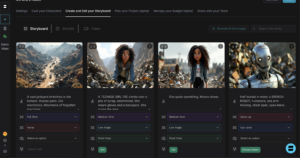Introduction
How to storyboard for a game requires unique planning approaches that traditional linear media cannot provide. Games demand interactive storytelling where player choices influence narrative outcomes. This creates complex design challenges that require careful visual planning.
Unlike films or animations, game storyboards must account for player agency. Users make decisions that change story direction. They explore environments at their own pace. They interact with characters in unpredictable ways.
Traditional storyboarding methods struggle with these interactive elements. Static frames cannot capture branching storylines effectively. Manual illustration becomes overwhelming when mapping multiple narrative paths.
Game development teams face unique coordination challenges. Programmers, artists, and designers must understand complex interactive systems. Clear visual communication becomes essential for successful collaboration.
Modern game designers are discovering AI-powered storyboarding solutions. These tools handle complex narrative branching automatically. Shai Creative’s intelligent storyboard generator understands interactive storytelling principles.
Ready to streamline your game development process? Start creating interactive game storyboards with Shai Creative and bring clarity to your complex narrative designs.
Why Storyboarding Matters for Games

Shai storyboard view showing AI-generated frames from uploaded script
Game development presents unique storytelling challenges that make visual planning absolutely critical. Interactive narratives branch in multiple directions. Players create their own story experiences through choice and exploration.
Interactive Storytelling Complexity
Games tell stories through player interaction rather than passive consumption. Cutscenes, dialogue trees, and environmental storytelling must work together seamlessly. Storyboards help designers coordinate these complex narrative elements.
Player choice creates multiple story paths that require individual planning. Each decision point splits the narrative into new directions. Visual planning helps teams track these branching storylines effectively.
Environmental storytelling requires careful visual design. Game worlds communicate story information through visual details. Storyboards help designers plan these subtle narrative elements systematically.
Team Coordination and Communication
Game development involves diverse creative disciplines working toward shared goals. Artists, programmers, and sound designers need unified creative direction. Storyboards provide essential visual references for team alignment.
Technical implementation requires clear creative specifications. Programmers need to understand narrative timing and interactive sequences. Visual storyboards communicate these requirements more effectively than written documentation.
Quality assurance teams use storyboards to verify implementation accuracy. They compare finished game sequences against planned visual references. This comparison helps identify bugs and inconsistencies early.
Player Experience Design
Games must maintain player engagement through interactive storytelling. Pacing, tension, and emotional beats require careful planning. Storyboards help designers orchestrate these experience elements effectively.
User interface integration affects story presentation significantly. Menus, inventory screens, and interactive elements must support narrative flow. Storyboards plan these integration points carefully.
Player agency requires balanced design between freedom and guidance. Too much freedom creates confusion. Too little freedom feels restrictive. Storyboards help designers find optimal balance points.
What Makes a Great Storyboard for Games

Shai’s intuitive interface where users can upload a script and generate visual storyboards, complete with scene sequencing, shot duration, and voiceover options — all in one platform.
Game storyboards must balance narrative planning with interactive design requirements. Each frame should consider player agency alongside traditional storytelling elements. Professional game storyboards guide complex development processes effectively.
Branching Narrative Structure
Choice points create multiple story paths that require systematic planning. Storyboards map these decision trees visually. They show how player choices affect subsequent narrative events.
Consequence visualization helps players understand choice impact. Major decisions should have clear visual outcomes. Storyboards plan these feedback mechanisms carefully.
Narrative convergence points bring branching stories back together strategically. Multiple paths often rejoin at key story moments. Visual planning helps designers coordinate these convergence sequences.
Player Agency Integration
Interactive elements require specific storyboard consideration. Clickable objects, dialogue options, and exploration opportunities need visual planning. These elements affect story pacing significantly.
Player perspective influences storyboard composition. First-person games need different visual approaches than third-person perspectives. Storyboards must account for these viewpoint differences.
Tutorial integration requires seamless narrative incorporation. Players need to learn game mechanics without breaking story immersion. Storyboards plan these educational sequences carefully.
Technical Implementation Planning
Engine capabilities influence storyboard complexity. Different game engines have varying technical limitations. Storyboards must work within these technological constraints.
Asset requirements affect production planning significantly. Character models, environments, and effects need coordination across development teams. Storyboards specify these asset needs clearly.
Performance considerations influence visual complexity. Mobile games have different technical requirements than console games. Storyboards must account for these platform limitations.
Traditional vs AI Storyboarding Tools

Edit AI-generated visuals directly in Shai with prompt tuning and framing controls
Traditional game storyboarding relies on manual illustration and complex documentation systems. These methods struggle with interactive narrative complexity. They create bottlenecks in modern game development pipelines.
Manual Method Limitations
Branching narrative documentation becomes overwhelming with traditional tools. Multiple story paths require extensive manual tracking. This complexity often leads to incomplete planning.
Revision cycles slow down iterative design processes. When narrative designers want changes, teams must manually update multiple story branches. These delays affect entire development schedules.
Team collaboration becomes difficult with static documentation. Multiple developers need access to evolving story plans. Traditional methods make real-time collaboration challenging.
AI-Powered Game Storyboarding
Shai Creative’s AI storyboard generator transforms game development planning. Advanced algorithms understand interactive storytelling principles. They generate comprehensive visual references for complex narrative systems.
AI storyboard generator showing interactive game sequence planning with branching narratives and player choice visualization
Branching narrative handling becomes automatic with AI tools. Systems track multiple story paths simultaneously. They maintain visual consistency across different narrative branches.
Speed advantages allow rapid iteration during game design. Generate multiple sequence variations quickly. Compare different narrative approaches before committing to specific directions.
Discover how AI-powered game storyboarding can streamline your development process while handling complex interactive narratives.
Step-by-Step: How to Storyboard for a Game
Define Your Story Goal
Game narratives serve specific player experience objectives. Define your core gameplay themes and emotional journey goals. These elements guide all subsequent creative decisions.
Player motivation drives engagement throughout game experiences. Identify what keeps players invested in your story. Document these motivation factors clearly for reference.
Genre conventions influence player expectations significantly. RPGs have different storytelling requirements than action games. Understand your genre’s narrative traditions and innovation opportunities.
Target platform affects story presentation methods. Mobile games need different pacing than console experiences. PC games allow different interface complexity than mobile platforms.
Identify Key Scenes or Interactions
Break your game story into essential interactive moments. Focus on choice points, cutscenes, and environmental storytelling opportunities. Not every interaction needs detailed storyboarding.
Critical path events require comprehensive planning. Main story progression points affect all players. These moments deserve detailed visual development and careful implementation planning.
Optional content needs coordination with main narrative threads. Side quests and exploration content should enhance rather than contradict primary story themes.
Tutorial sequences require special attention in game storyboards. Players must learn mechanics without losing narrative engagement. Plan these educational moments carefully within story context.
Create Visual Frames
Transform interactive concepts into clear visual representations. Consider player perspective, interface elements, and environmental storytelling opportunities in each frame.
AI tools accelerate complex game visualization significantly. Generate multiple scene variations quickly. Explore different camera angles and environmental approaches efficiently.
User interface integration requires careful visual planning. Menus, inventories, and interactive elements must support story presentation. Plan these interface elements within narrative context.
Environmental storytelling needs systematic visual development. Background details communicate narrative information subtly. Storyboards coordinate these environmental story elements effectively.
Add Detailed Annotations
Game storyboards require comprehensive interactive specifications. Include choice consequences, trigger conditions, and technical implementation notes. These details guide programming teams through complex systems.
Player agency documentation helps developers understand intended user experiences. Specify available actions, movement restrictions, and interaction possibilities for each sequence.
Technical requirements guide different development disciplines. Programming notes specify trigger conditions. Art notes describe asset requirements. Audio notes indicate sound design needs.
Timing considerations account for player-controlled pacing. Unlike linear media, games allow players to control story speed. Plan for various player behavior patterns.
Review and Collaborate
Implement structured review processes with programming, art, and design teams. Their technical input prevents implementation problems before they become expensive to fix.
Playtesting integration helps validate storyboard effectiveness. Test planned sequences with actual players. Observe how they interact with designed choice points and narrative elements.
Version control becomes critical with complex branching narratives. Maintain clear documentation as story designs evolve. Ensure all team members work with current specifications.
Tips for Optimizing Storyboards for Games

Customize characters to maintain visual consistency across shots
Player Choice Architecture
Design meaningful choices that affect story outcomes significantly. Trivial decisions frustrate players and waste development resources. Focus choice points on important narrative moments.
Consequence clarity helps players understand decision impact. Visual feedback should communicate choice results effectively. Plan these feedback mechanisms in storyboard sequences.
Choice recovery allows players to course-correct after regrettable decisions. Not all choices should have permanent consequences. Balance player agency with story coherence requirements.
Interactive Pacing Control
Player-controlled timing requires flexible story presentation. Some players rush through dialogue while others read carefully. Design story sequences that accommodate different play styles.
Skippable content respects player preferences without breaking narrative flow. Cutscenes should be interruptible without losing essential story information.
Attention management guides players toward important story elements. Visual design should highlight critical narrative information clearly.
Technical Implementation Planning
Performance optimization affects story presentation quality. Complex cutscenes require careful technical planning. Balance visual ambition with platform capabilities.
Asset reuse reduces development costs and improves consistency. Plan character models, environments, and effects for multiple story contexts.
Localization requirements influence text presentation and voice acting coordination. Plan story sequences for multiple language implementations.
Common Mistakes to Avoid
Over-Complex Branching Systems
Many game designers create overly complicated choice trees that become impossible to track. Players get lost in complex decision networks. Focus on meaningful choice points rather than excessive branching.
Technical feasibility often gets overlooked during ambitious story planning. Every choice point requires programming implementation. Balance narrative ambition with development resources.
Player Agency Misunderstanding
False choices frustrate players when decisions don’t create meaningful differences. Ensure choice points actually affect story outcomes. Don’t create illusion of agency without substance.
Choice overwhelm occurs when players face too many decisions simultaneously. Limit simultaneous options to manageable numbers. Guide players toward important decisions clearly.
Implementation Disconnect
Story-gameplay separation creates jarring player experiences. Narrative elements should integrate with core gameplay mechanics. Plan story sequences that support rather than interrupt gameplay flow.
Technical constraint ignorance leads to impossible implementation requirements. Collaborate with programming teams during storyboard development. Ensure planned sequences can be built successfully.
Why Use an AI Storyboard Generator Like Shai
AI-powered storyboarding transforms game development from complex manual planning into streamlined creative exploration. Shai Creative’s AI storyboard generator handles branching narrative complexity automatically while maintaining visual consistency.
Branching Narrative Management
AI systems track multiple story paths simultaneously without manual coordination overhead. Generate comprehensive visual documentation for complex choice trees. Maintain consistency across different narrative branches automatically.
Choice consequence visualization becomes systematic with AI assistance. Generate visual representations of decision outcomes quickly. Compare different choice architectures before committing development resources.
Development Team Coordination
Visual consistency helps diverse development teams understand complex interactive systems. AI-generated storyboards maintain professional quality across all sequences. This consistency improves communication between artists, programmers, and designers.
Technical specification integration ensures storyboards include necessary implementation details. AI systems understand game development requirements. They generate documentation that guides programming teams effectively.
Creative Exploration Capabilities
Rapid iteration allows exploration of multiple narrative approaches. Generate alternative story sequences quickly. Compare different player agency implementations before final decisions.
Creative flexibility supports innovative storytelling approaches. AI tools don’t limit designers to traditional narrative structures. Explore unique interactive storytelling possibilities efficiently.
Transform your game development process with Shai Creative and discover how AI-powered storyboarding enhances interactive narrative design while streamlining development workflows.
Final Thoughts + Next Steps
Effective storyboarding transforms game development from chaotic improvisation into organized creative execution. Interactive narratives require more complex planning than linear media. Professional storyboards guide successful game development.
Player agency creates unique design challenges that traditional storytelling methods cannot address. Game storyboards must balance narrative control with player freedom. This balance requires careful visual planning and systematic approach.
AI-powered tools like Shai Creative revolutionize game development planning. They handle branching narrative complexity automatically. Modern game teams need these technological advantages for competitive success.
Your next game project deserves professional storyboard quality that handles interactive complexity. Don’t let manual planning limitations restrict your creative vision. Embrace AI-powered solutions that enhance creativity while improving development efficiency.
Start creating professional game storyboards that transform interactive concepts into development-ready guidance. Your team and your players will benefit from this improved planning approach.